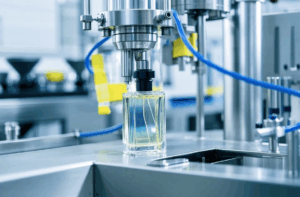目录
ToggleIn the modern fragrance industry, the perfume filling machine plays a critical role in optimizing production efficiency, ensuring precision, and meeting evolving market demands. As consumer preferences shift toward niche fragrances, sustainable formulas, and premium packaging, manufacturers are increasingly investing in advanced machinery. The integration of state-of-the-art perfume filling machines can transform traditional production lines by enhancing accuracy, minimizing contamination, and increasing output while maintaining high-quality standards.
The Role of Perfume Filling Machines in Precision Filling
High-Precision Pump Technologies
Modern perfume filling machines often utilize high-precision technologies like peristaltic pumps, which are designed to maintain hygiene and eliminate cross-contamination between different fragrance formulations. These pumps enable the system to fill bottles with an error margin as low as ±0.5%, which is especially important for boutique or salon-grade fragrances where consistency is key.
- Accuracy: Digital control systems regulate the volume to the milliliter, ideal for 30ml, 50ml, or 100ml bottles.
- Clean filling process: The fluid only touches the inner tube of the pump, minimizing residue buildup.
- Flexibility: Peristaltic systems can easily switch between different formulations without needing full disassembly and cleaning.
By reducing human error and maintaining consistent product volume, perfume filling machines improve batch-to-batch reliability, which is vital in preserving brand reputation and consumer trust.
Perfume Filling Machines and the Rise of High-End Domestic Perfume Brands
Responding to the Salon Fragrance Boom
In recent years, a noticeable trend has emerged: the rise of high-end domestic perfume brands, particularly in markets like China where niche or “salon” perfumes are booming. These brands prioritize small-batch production, rare ingredients, and artisanal craftsmanship. The perfume filling machine allows such brands to maintain exclusivity while still meeting increasing demand.
- Small-batch adaptability: Machines can be calibrated for low-volume runs (as low as 100 bottles/hour).
- Automated batch tracking: Integration with smart factory systems allows traceability of each fragrance batch, critical for regulatory compliance.
- Customization: Capable of handling various bottle shapes and closure types, enabling creative brand differentiation.
The perfume filling machine thus bridges artisanal quality with scalable efficiency, supporting the sector’s shift from mass production to personalized luxury.
Enhancing Sustainability with Advanced Filling Systems
Eco-Friendly Practices in Fragrance Manufacturing
Sustainability has become a core concern in the fragrance industry. Companies like P2 Science are innovating with bio-based fixatives and biodegradable scent molecules. However, these green formulations often have different viscosities and volatility compared to traditional ingredients, requiring specialized filling equipment. The latest perfume filling machines are designed to adapt to such variables without compromising speed or accuracy.
Key features enhancing sustainability:
- Reduced material waste: High fill accuracy minimizes overfilling and product loss.
- Energy-efficient motors: Machines with variable frequency drives reduce electricity consumption by up to 25%.
- Reusable packaging compatibility: Supports refillable bottles and cartridge-style designs gaining popularity in zero-waste retail models.
Incorporating sustainable practices into manufacturing not only lowers environmental impact but also aligns with growing consumer demand for green luxury.

Additional Efficiency Gains Through Automation
Integration and Smart Manufacturing
The efficiency of a perfume filling machine also lies in its integration with other components in a production line—labeling, capping, sealing, and coding. When synchronized through a central control system, these machines can increase throughput by 30–50% compared to manual or semi-automated lines.
Benefits include:
- Real-time diagnostics: Sensors detect underfilled or misaligned bottles and auto-correct without halting the line.
- Remote control and maintenance: IoT-enabled systems allow for remote monitoring, predictive maintenance, and system updates.
- Modular design: Expandable setups accommodate seasonal surges in demand or product diversification.
Such automation capabilities ensure that perfume brands can respond quickly to market trends without compromising on quality or delivery schedules.
Conclusion
In conclusion, the perfume filling machine is no longer a simple production tool—it is a cornerstone of modern fragrance manufacturing. Whether supporting high-precision filling, enabling boutique brand scalability, or adapting to eco-conscious formulas, it enhances efficiency across every stage of the process. As the global perfume market continues to evolve—expected to reach over USD 69 billion by 2030—the role of intelligent, flexible, and sustainable perfume filling machines will become even more vital. By leveraging these technologies, perfume producers can not only streamline operations but also position themselves at the forefront of innovation and consumer satisfaction.
0